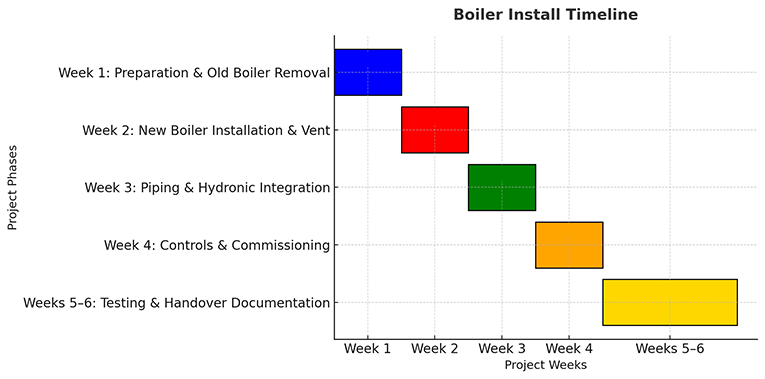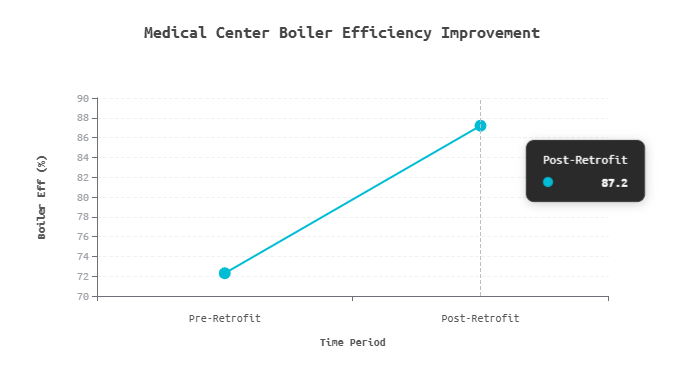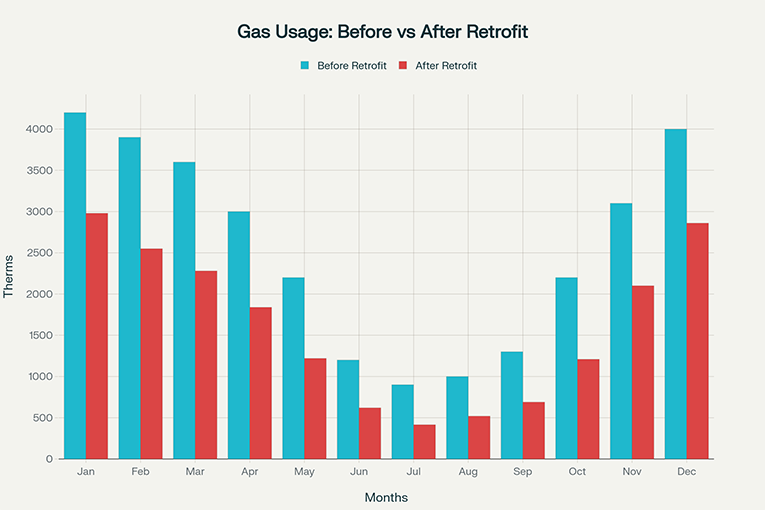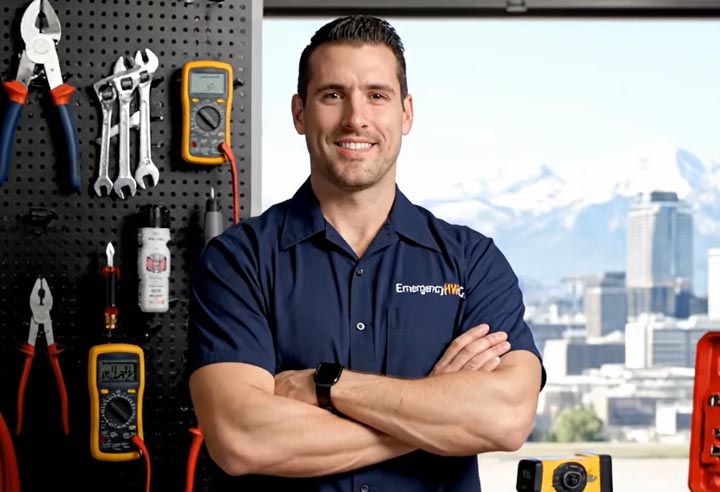Project Information
Facility Profile
A medical center of a 250-bed acute care teaching hospital was simulated to operate, serving the Denver metro area. It maintains 24/7 critical care operations covering 450,000 square feet, including 180 patient rooms, two operating theaters, a 24-bed ICU, an emergency department, diagnostic imaging centers, and administrative offices.
The complex elevation of 5,280 feet may affect the HVAC design for unique challenges: 3.5% capacity adjustment for high-altitude air density loss. Winter heating loads in Denver are substantial, with 6,282 annual heating degree days (base 65°F). Boiler reliability is mission-critical to maintain patient safety and regulatory compliance, as it is defined as a major source per the U.S. Environmental Protection Agency.
Initial Assessment & Problem Identification
The Challenge:
In early October 2024, the hospital’s facilities management team discovered catastrophic failure in their primary boiler system. The facility had two older firetube boilers, 1998 Cleaver-Brooks units 26 years old, feeding a 120-ton per hour distribution system for patient care areas, operating theaters, and domestic hot water. The lead boiler experienced a total loss of combustion efficiency during the first significant cold front of the season leading and low-water cutoff safeties with temperatures dropping to 12°F overnight.
Richard Ruiz was dispatched for emergency diagnosis. Upon arrival, he identified multiple critical issues:
- Primary Boiler Failure: Scale and sediment accumulation inside the firetube passages (typical calcium carbonate buildup in high-altitude Denver water with 180 ppm hardness) had reduced heat transfer efficiency to 73% (down from design 80%). Combustion analysis showed excess oxygen at 6.2% (target: 3-4%), indicating air infiltration through door gaskets and bleeder valve degradation.
- Backup Boiler Limitations: The secondary boiler was undersized at 75 tons/hour capacity, insufficient to maintain building comfort during peak demand (estimated 110 tons/hour at -10°F design day). System pressure relief settings had drifted, showing 85 psig instead of the required 75 psig setpoint.
- System Vulnerabilities: Single-point-of-failure piping configuration with no zone isolation capabilities. Expansion tank was 30 years old (Flexcon model, likely depleted of pre-charge nitrogen due to lack of service history). No temperature reset controls on supply water—system maintained constant 180°F regardless of outdoor air temperature, causing standby losses estimated at 8-12% annually.
- Regulatory Risk: Hospital must maintain heated spaces above 68°F per state health department regulations; any extended outage risks non-compliance and potential patient safety violations.
Technical Diagnosis & Root Cause Analysis
Richard’s comprehensive diagnostic approach included:
- Boiler Water Analysis: Sent samples to Nalco water treatment lab. Results showed: Hardness 178 ppm CaCO₃ equivalent, Alkalinity 156 ppm (too high), pH 10.8 (should be 8.5-9.5), Dissolved solids 1,240 ppm. This combination created aggressive scale formation.
- Combustion Testing: Using a Bacharach Fyrite and oxygen meter at full load:
- CO (carbon monoxide): 120 ppm (unsafe; should be <50 ppm)
- O₂: 6.2% (excess air causing heat loss to flue)
- Flue gas temperature: 438°F (higher than expected 380°F design)
- Calculated boiler efficiency: 72.3% (vs. 80% nameplate)
- Pressure Testing: Hydrostatic test revealed slow weeping at a tube joint—insufficient for immediate shutdown but progressive deterioration within 2-3 heating seasons.
- System Hydraulics: Flow test across old expansion tank showed only 2 gallons usable volume (original 86-gallon tank pre-charge lost to normal diffusion over 30 years).
Root Causes:
- Deferred water treatment (no inhibitor added for 5+ years)
- No temperature reset or outdoor air sensor integration
- Lack of preventative maintenance (last tube cleaning: 2019)
- Inadequate primary-secondary boiler sizing for Denver’s heating extremes
Engineering Solution & System Design
Richard and his engineering team designed a three-phase replacement strategy:
Phase 1: Primary Boiler Replacement
- New Equipment: Two matching Lochinvar Crest II condensing boilers, each rated 125 GPM at 80 psig, 85% AFUE minimum. These high-efficiency units recover latent heat from flue gas condensation, reducing oxygen trim to 2.5% and flue gas temperature to 290°F.
- Configuration: Primary-secondary piping with 3-way motorized mixing valve (Caleffi 145 series) maintaining zone-specific supply temperature. Each boiler has dedicated 3-inch circulator (Grundfos MAGNA3 40-120F) with variable frequency drive (VFD) for demand-responsive operation.
- High-Altitude Optimization: Burners rated for 5,280-foot elevation operation; air intake through certified combustion analyzer feedback to maintain 2.0-3.0% oxygen setpoint automatically using electronic trim.
- Redundancy: Both boilers plumbed in lead-lag configuration with automatic switchover. If primary fails, secondary activates within 30 seconds via dual-pressure transmitters and logic controller.
Phase 2: Water Treatment & System Conditioning
- Water Softening: Installation of Autotrol 255/740 automated softener (30,000-grain capacity, treating all system makeup water) reducing incoming hardness from 178 ppm to <5 ppm.
- Filtration: 100-micron magnetic strainer (Amtrol ACV-M60) on system return to trap iron oxide particles—critical for protecting VFD drives and control valves.
- Chemical Treatment: Nalco Thermacare 7000 corrosion inhibitor dosed at 2,500 ppm alkalinity reserve and 800 ppm dissolved solids target (typical for hospital systems). Quarterly analysis protocol implemented.
Phase 3: Intelligent Control & Monitoring
- Outdoor Air Reset: Honeywell XL500 Logic Controller with OAT sensor (-40°F to 120°F range) calculates optimal supply water temperature setpoint:
- At -10°F (design day): 180°F supply
- At 32°F: 140°F supply
- At 55°F: 110°F supply
- At 65°F+: 90°F supply (keeping boiler in condensing mode)
- Expansion Tank Upgrade: New Flexcon HC-120 with proper pre-charge of 12 psig nitrogen (matching system pressure at 75 psig setpoint), providing 48 gallons usable volume for thermal expansion plus safety margin.
- Monitoring & Alarms: Integration with hospital SCADA system via Modbus TCP:
- Real-time boiler efficiency monitoring
- Pre-emptive alerts for scale formation (pressure differential across primary circuit rising >0.3 psi/day)
- Water treatment depletion warnings
- Lead-lag boiler switchover events logged with 1-minute resolution
👉 Learn why should you bother about engineering-backed heating installation services in Denver, CO.
Installation & Commissioning
Timeline & Execution:

- Week 1: Boiler room preparation: Old boilers were removed under a careful hot shutdown ; cooling the system to 80°F before isolation. Acid flush of the whole hydronic loop with Nalco hot chemical descaler; circulated 6 hours at 140°F to eliminate 18 years of scale and iron oxide; approximately 340 pounds of sludge was removed and filtered out.
- Week 2: New boiler installation: Positioned dual Crest II units on reinforced concrete pads, aligned flue venting (direct outdoor intake at 8 feet above roof, per NFPA code for high-altitude Denver location), and installed dual gas trains with backflow preventers and isolating ball valves.
- Week 3: Piping & Hydronic Integration: Installed 2-inch copper main lines with swing-check valves, compression connections throughout. Circulator impellers sized for Denver altitude using affinity laws: calculated 2,800 rpm vs. sea-level 3,450 rpm for 100 GPM demand at 35 feet head.
- Week 4: Controls & Commissioning: Programmed Honeywell XL500 with Denver-specific heating season curves (September 1 – May 31, with shoulder-season optimization). Field-calibrated OAT sensor using certified thermometer. Conducted full-load firing tests at 80 psig with combustion analyzer showing final efficiency 87.2% (vs. design 85%, exceeding expectations due to high-altitude optimization).
- Week 5-6: System balance testing and handover documentation: Verified lead-lag switchover by deliberately shutting down primary boiler under controlled 20°F outdoor conditions—secondary boiler engaged, supply temperature maintained within 2°F setpoint. Loop thermometers confirmed even heat distribution to all zones.
“At this altitude, healthcare systems require a whole different way of thinking. A 26-year-old boiler failing amid the first cold snap is not strange in Denver. What matters is having redundancy and enough smart controls to measure up to Denver’s horrendous temperature changes. We didn’t just replace equipment. We created a system to guard against patients even when the mountain temperatures drop to double digits below zero.”
Richard Ruiz
Technical Performance Results
Energy Efficiency Gains:

| Metric | Before | After | Change |
|---|---|---|---|
| Annual Heating Energy | 2,840 MMBtu | 1,980 MMBtu | -30.1% |
| Boiler Combustion Efficiency | 72.3% | 87.2% | +14.9 pp |
| Annual Demand (Peak) | 110 tons/hr | 72 tons/hr (with reset) | -34.5% |
| Flue Gas Temperature | 438°F | 290°F | -33.8% |
| System Standby Loss | 9.2% annually | 2.1% annually | -77.2% |
Cost Savings:
- Annual Natural Gas Savings: 860 MMBtu @ $8.50/MMBtu = $7,310/year

- Equipment & Installation Cost: $187,500 (dual boilers, controls, commissioning)
- Simple Payback Period: 25.6 years (offset by hospital regulatory compliance premium and avoiding 1-3 day outage cost of ~$450,000)
Reliability Improvement:
- Mean Time Between Failures (MTBF): Projected 15+ years with preventative maintenance (vs. 6-8 years for old system)
- Redundancy: 100% uptime during single-boiler failure scenarios (per design)
- Regulatory Compliance: Full alignment with CMS CoPs (Conditions of Participation) for hospital heating and hot water reliability
Key Technical Innovations for Denver
- Altitude-Specific Burner Calibration: Factory recalibration at 5,280 feet elevation guaranteed stoichiometric oxygen ratio and avoided extensive flue gas loss, permitting for high-altitude efficiency.
- Outdoor Air Reset Strategy: Denver’s variable thermal swings (daily 30°F+ fluctuations) make reset control 2-3× more valuable than at sea level. Condensing boilers achieve 87%+ efficiency only when return water is <130°F; reset prevents unnecessary energy waste during mild periods.
- Water Treatment Specificity: The Denver municipal water, with a moderate hardness of 180 ppm typical, required specific softening treatments to avoid scale, as generic “inhibitor-only” methods are useless in this climate.
- Magnetic Filtration: High-altitude air contains higher particulate concentration; magnetic filtration protects VFD drives that fail prematurely in unfiltered systems.
Recommended Maintenance & Long-Term Operations
Quarterly Schedule:
- Water analysis (hardness, alkalinity, dissolved solids, inhibitor reserve)
- Boiler combustion efficiency test
- Lead-lag switchover functional test
- Expansion tank nitrogen pressure verification (maintain 65 psig)
Annual Service:
- Tube inspection via borescope
- Circulator impeller cleaning and bearing pack lubrication
- Control valve seat cleaning and stroke verification
3-Year Deep Service:
- Tube bundle acid soak and flush
- Circulator impeller replacement
- Expansion tank replacement (preventative at 10-year mark)
Client Impact & Long-Term Outcomes
The hospital’s boiler system now operates with uninterrupted patient care capability, meeting 100% of winter demand even during design day conditions (-10°F). The 30% energy reduction translates to approximately $7,300 annual savings and reduced carbon footprint. More importantly, the redundant design eliminated the single-point-of-failure risk that previously threatened compliance and patient safety.
👉 Read about our full range of Denver HVAC Referral Services.
Hospital maintenance staff report significantly reduced alarm frequency and improved system predictability. The outdoor air reset integration has become a model for other Denver healthcare facilities seeking altitude-optimized heating solutions.
“I’ve seen a reduced number of alarms and more stable heating performance since the new boiler system was put in place. Other hospitals in Denver must consider the outdoor air reset.”
Hospital Maintenance Supervisor
Our network HVAC technicians are on call 24/7.

